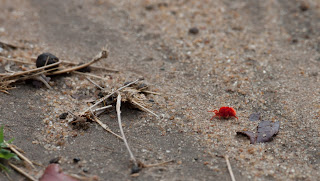Little did we know as we set out on the morning of our third day in Selous, that today was going to be a day of wildlife experiences.
Today's goal was to drive to one of the largest accessible water-bodies from the camp and explore around there.
On the way prominent
African Fish Eagle was perched:
An
African Openbill Stork was preening:
I think this one is a female Amethyst Sunbird:
Having seen birds of prey landing, we approached one spot to find an adult
Bateleur Eagle perched:
together with a juvenile:
As we approached closer though we found out what had been attracting the birds as a Hyena quickly dragged an Impala carcass away from us into dense undergrowth.
We got to the edge of the lake and looked around, seeing a small brightly coloured bird, the Golden Pipit:
Ezra explained that these only really occur during the rainy season which meant seeing this was an unexpected bonus and certainly a treat for us.
Further round the lake edge a large swarm of crocodiles were tearing-up a Buffalo. Given that crocodiles wouldn't normally attack something so big our guides speculated that the animal may have got stuck in deep wet mud, which made it vulnerable.
Certainly the crocodiles were taking no time in dismembering it, including the barrel-roll we'd only previously seen on wildlife documentaries:
One of my favourite encounters of the day was seeing Black Egrets doing their dracula impression (ok it's not that but they sweep their wings about to create private cover in which they hunt, as you can see from this sequence:
I'd long wanted to see this and was very happy to have done so.
Another corner another experience, this a long-dead Giraffe being consumed by a multitude of carrion birds:
With those having taken their fill perched close-by:
Young buffalo were suitably nervous approaching the lake to drink:
On the road back to camp we stopped to watch a
Black-chested Snake-Eagle consume a snake on the wing:
And a dung beetle doing its thing:
After lunch we set out again, seeing a number of more common species but in good light including this
Greater Blue-eared Starling:
Lilac-breasted Roller:
Little Bee-eater:
We stopped at one pool to watch a mother hippo escorting her youngster through a horde of crocodiles all of whom were testing her to see if they could get to her offspring while it was so small and vulnerable. The young hippo kept trying but failing to climb onto its mother's back. All the while the crocodiles circled with more slipping into the water. She had to attack forward to make space for them to move into as they crossed the waterbody:
We didn't think she'd get them both across but she did.
One species of bird that always catches the eye is the Northern Carmine Bee-eater, here with a bee being beaten on a branch to remove the sting:
At one point from the road we saw a pair of
Red-necked Falcons:
Another Spotted Hyena this one had been wallowing in a shallow mud-pool:
A Greater Blue-eared Starling which fought on and off with a Nubian Woodpecker:
A Yellow-billed Oxpecker in a tree:
Yellow Baboon with young:
All around the park animals had young or were about to have young in anticipation of the short rain. After one particularly abrupt outburst of rain, we sat drying off, trying to identify a species of bird, a group of which were calling from a shrub complex. The odd one settled sufficiently long enough for me to grab some photographs.
The sense was Babbler but we needed to get the images onto a bigger screen back at camp, where we were able to identify them as
Hartlaub's Babbler:
So ended another splendid day in Selous and thankfully back in camp there were no lions to be seen or indeed heard over dinner, though we did have some of our food taken by one of the resident bush babies, which by the way make the most amazing racket during the night when you;re trying to sleep. They call and call and call, up to an hour at a time, very close, piercingly noisy too. We didn't get much sleep as a consequence until after a couple of nights we were so tired we slept through anyway.










































































